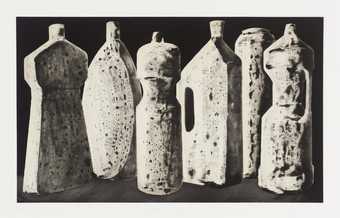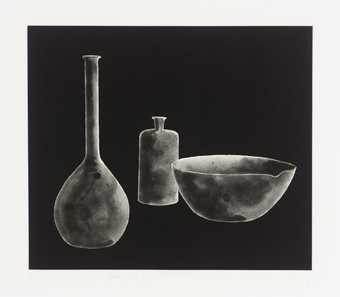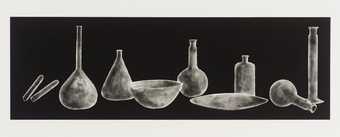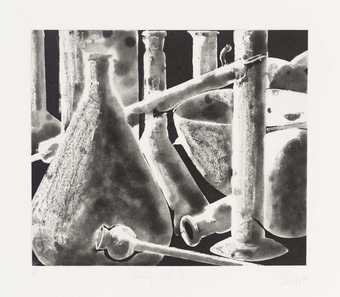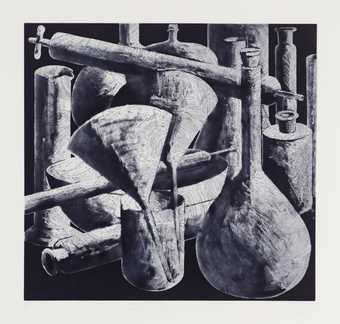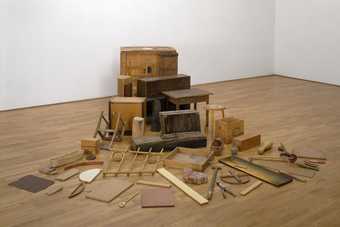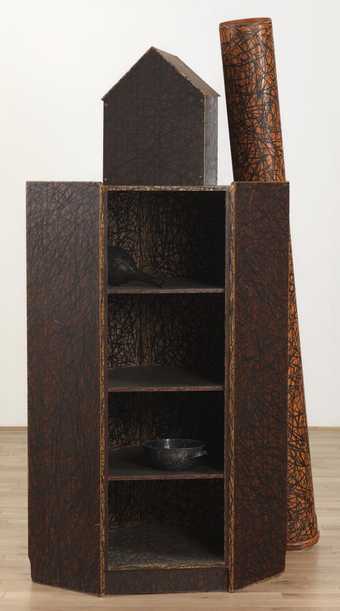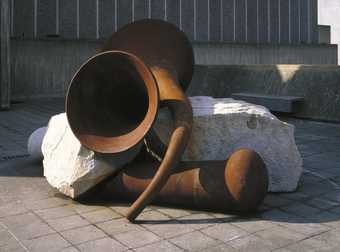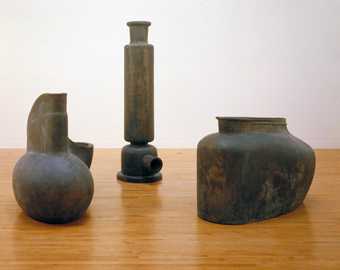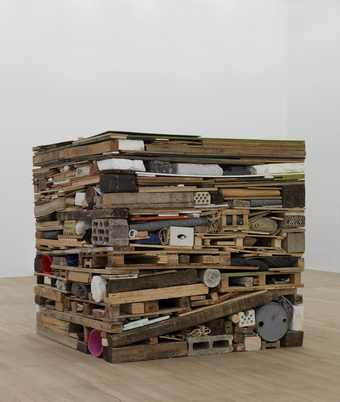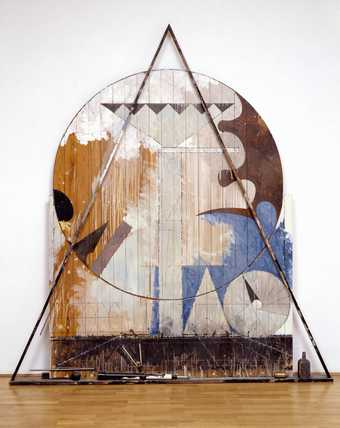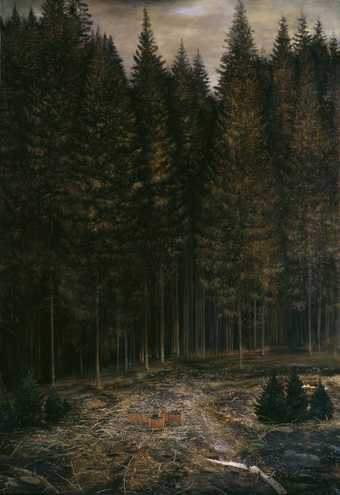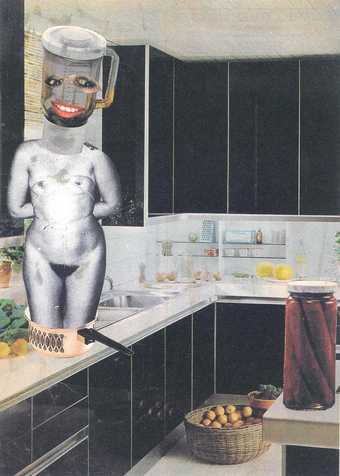
In Tate Liverpool
- Artist
- Tony Cragg born 1949
- Medium
- Glass
- Dimensions
- Unconfirmed: 2650 × 1200 × 1200 mm
- Collection
- Tate
- Acquisition
- Presented anonymously 2001
- Reference
- T07792
Summary
Cumulus is a cuboid assemblage of glass vessels which have been sandblasted to a milky translucent finish. The many tiers of glasses, vases, bottles and bowls have been arranged upon several layers of plate glass like an extravagant wedding cake. The commercially produced vessels are of varying forms and sizes, from diminutive goblets to large cylindrical vases. Their sandblasted surfaces suggest the slow process of erosion, accelerated here by the use of modern technology. Although it appears that the layers of vessels support the glass shelves above, on which further vessels are placed, the shelves are in fact supported by square glass bricks that form the central core of the sculpture. One meaning of the title, Cumulus, is an accumulation, a word which aptly describes much of Cragg's sculptural practice. It also, of course, alludes to the cloud formation frequently seen in summer skies. The curving volumes of the milky-white vessels recall the cotton-wool puffiness of cumulus clouds.
The motif of the vessel recurs throughout Cragg's work, from the modest Five Bottles on a Shelf in 1980 (private collection) to the giant steel bottles of Bestückung in 1987-8 (private collection). In 1989, David Batchelor commented on this recurring motif: 'it carries with it both a sense of historicity and of modernity. It is culturally weighty: archaeology, tradition and bearer of basic sustenance; and in its contemporaneity it is all contingency and transience: mass production and its necessary counterpart, mass disposal. It is classical Greece and it is Pop Art.' (Tony Cragg, exhibition catalogue, Stedelijk Van Abbemuseum, Eindhoven 1991, p.6.) In Cragg's print, Six Bottles (Large), State 1, 1998 (Tate P77288), the bottle motif assumes geological and archaeological overtones. The print depicts a row of plastic bleach and washing-up liquid bottles. Pockmarked during the printmaking process by acid burns and blisters, their pitted surfaces recall the rough craters of eroded rock. An informal line-up of modern, plastic ephemera thus takes on the appearance of a monolithic rock formation, collapsing the polarity between nature and culture, past and present.
The multi-layered structure of Cumulus also recalls Cragg's early 'stack' works, one of which is in Tate's collection (Stack 1975, Tate T07428). Stack consists of a multitude of miscellaneous objects and materials packed tightly together to form a solid cube. Like the shelves of glass in Cumulus, pieces of wood are placed horizontally throughout Stack, compressing the materials into dense strata and conveying the impression of geological layers. Stack resembles a cross-section view of long-forgotten, buried rubbish. This reference to geology and archaeology resounds throughout Cragg's career and is continued with Cumulus. He identifies as a key theme in his work a concern with humankind's impact on nature. Insisting that what we call the 'natural world' is increasingly man-made, Cragg has said that he 'refuse[s] to distinguish between the landscape and the city', adding that man-made objects are 'fossilized keys to a past time which is our present' (quoted in Tony Cragg, exhibition catalogue, Hayward Gallery, London 1987, p.26-28).
Further reading:
A New Thing Breathing: New Work by Tony Cragg, exhibition catalogue, Tate Liverpool, Liverpool 2000, reproduced in colour, p.108.
David Sylvester, 'Almost a Pauseless Thing', Modern Painters, vol.13, no.2, summer 2000, pp.66-72, reproduced in colour, p.67.
Tony Cragg: Sculpture 1975-90, exhibition catalogue, Newport Harbor Art Museum, Newport Beach 1990.
Helen Delaney
January 2002
Does this text contain inaccurate information or language that you feel we should improve or change? We would like to hear from you.
Display caption
Cumulus is comprised of glass vessels that have been sandblasted to a milky translucent finish. Their surfaces suggest the slow process of erosion, accelerated here by the use of modern technology. Each level of vases, bottles and bowls appears to support the glass shelf above. In fact, the shelves are supported by square glass bricks that form the central core of the sculpture.Cumulus is an ‘accumulation’, a word describing much of Cragg's sculptural practice. He is known for collecting and arranging found objects, with references to geology and archaeology, past and present, nature and culture.
Gallery label, May 2007
Does this text contain inaccurate information or language that you feel we should improve or change? We would like to hear from you.
Explore
- emotions, concepts and ideas(16,416)
-
- formal qualities(12,454)
-
- classification(114)
- repetition(391)
- universal concepts(6,387)
-
- environment / nature(315)
- social comment(6,584)
-
- machine age(49)
You might like
-
Tony Cragg Six Bottles (Large), State 1
1988 -
Tony Cragg Laboratory Still Life No. 1, State 1
1988 -
Tony Cragg Laboratory Still Life No. 2, State 1
1988 -
Tony Cragg Laboratory Still Life No. 3
1988 -
Tony Cragg Laboratory Still Life No. 4
1988 -
Linder She/She
1981, printed 2007 -
Linder She’s too much for my mirror
1979, 2008 -
Tony Cragg Axehead
1982 -
Tony Cragg Mineral Vein
1986 -
Tony Cragg Raleigh
1986 -
Tony Cragg On the Savannah
1988 -
Tony Cragg Stack
1975 -
Michael Kenny The Astronomer
1984 -
Ged Quinn Cross in the Wilderness
2003–4 -
Linder Untitled
1976

